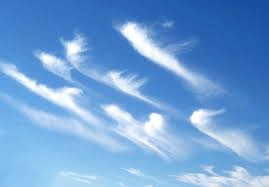a mixture of gases that surrounds the Earth
Atmosphere
an increase in temperature with height in an atmospheric layer
temperature inversion
small particle in the atmosphere around which water droplets form
condensation nucleus
Layer that humans live in and breathe
Troposphere
all forms of water that fall from clouds
Precipitation
The atmosphere consists mainly of:
Nitrogen 78% and oxygen 21%
the amount of water vapor in the atmosphere at a given location on Earth's surface
humidity
occurs when air masses move into the same area from different directions
convergence
Layer that contains the ionosphere
Thermosphere
the extra thermal energy contained in water vapor compared to liquid water
Latent Heat
gas molecule that is made up of three oxygen molecules
ozone
occurs when the amount of water vapor in a volume of air has reached the maximum amount
saturation
puffy, lumpy-looking clouds

cummulus
High Concentration of Ozone
Stratosphere
the transfer of thermal energy between objects when their atoms or molecules collide
Conduction
tiny, solid particles that are in the atmosphere such as dust, microscopic organisms, and pollen
particulates
the amount of water vapor in a volume of air relative to the amount of water vapor needed for that volume of air to reach saturation
relative humidity
layered, sheet-like clouds
stratus
All weather occurs in this layer
Troposphere
occurs when cloud droplets collide and join together to form a larger droplet
Coalescence
the five layers of the atmosphere
troposhpere, stratoshpere, mesosphere, thermosphere, exosphere
the temperature to which air must be cooled at constant pressure to reach saturation
dew point
wispy, indistinct clouds

cirrus
Magnetic storms called auroras occur in this layer
the transfer of thermal energy by the end of the movement of heated material from one place to another
Convection